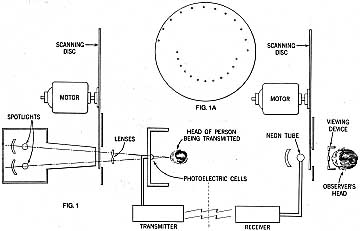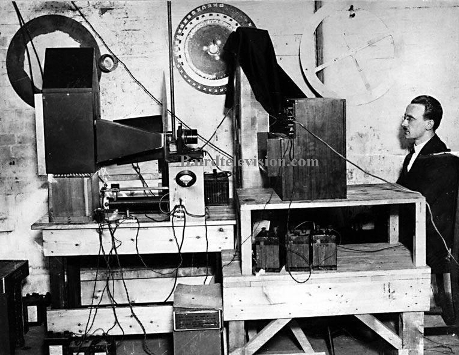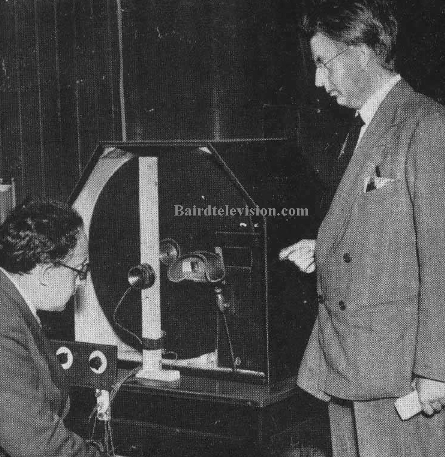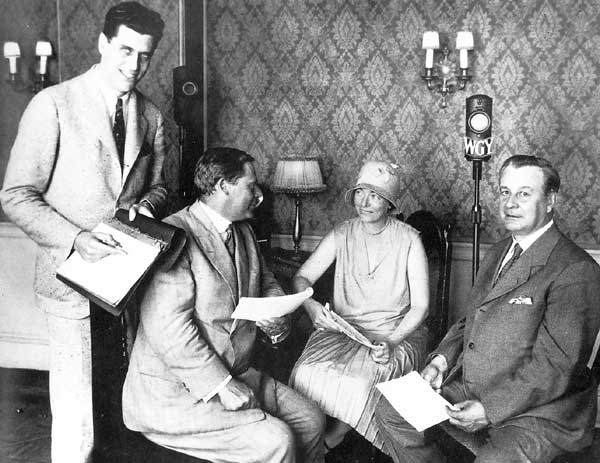John L. Baird Produces Moving Images Which Are Given the Appearance of Solidity
Mr. Baird (above) is here shown demonstrating his “stereovision” receiver. The
familiar eyepiece with its twin prisms is at the right of the apparatus; the Baird
receiver’s “frame”, the image at the side of the scanning disc instead of the top. The
microphone in front of this receiver is for communication with the transmitting room.
The last few months have witnessed spectacular advances in television. In June, John L. Baird demonstrated before Professor Fleming and other distinguished scientists and press representatives the transmissions of persons illuminated only by ordinary daylight, thus removing television from the laboratory to the out-of-doors. This was followed almost immediately by transmission of objects in natural colors, as described in Radio News for October; and now, immediately on top of all this, comes the demonstration of stereoscopic television.
Television images in, apparently, three dimensions were demonstrated for the first time on August 10 in the Baird Laboratories in Long Acre, before an audience of scientists and representatives of the press.
The Principle of the Stereoscope

The “Stereoscope” transmitter is shown in diagram form
at the left, and the receiver at the right. The disc
(Fig. 1A) scans two distinct images, one for each eye.
Stereoscopic television gives the image the appearance of solidity and depth, so that it does not look like a flat picture, but like an actual living object. The stereoscope does the same thing for photography and, in explaining stereoscopic television, we must first examine the principles of stereoscopy. The appearance of solidity or depth which we have arises from the fact that we have two eyes, each of which sees the scene from a slightly different viewpoint. The mind combines these two different images into one, and it is the blending of the left-eye and right-eye images that gives the impression of depth.
In the stereoscope, with which we are all familiar, two photographs taken by camera separated by a distance equal to or greater than the distance between the two eyes, are places side by side in a viewing device consisting of two prisms, so arranged that on looking through the prisms the images are converging and made to overlap. The extraordinary result is then obtained that, instead of our seeing two overlapping images, the mind combines these two dissimilar pictures into one composite view; and this composite view does not appear as a flat photograph, but gives the observer the impression that he is looking into the actual scene itself. The illusion is very striking.
A Double Television Image
By applying the stereoscope principle to television, it has now become possible to transmit television images with all the appearance of depth and solidity; and, by a further combination of colored television with stereoscopic television, the complete illusion of images in natural colors, and with depth and solidity becomes possible. All this has been recently demonstrated in the Baird Laboratories.

In this picture of the Baird transmitter, the photoelectric cells are in the box at the right: S, light-source; D, scanning disc; L, lens; C, cloth covering cells; P, subject undergoing television.
The transmitting apparatus consists of a disc, perforated as shown in Fig. 1A with two spirals; the first spiral being arranged round one-half of the circumference of the disc. The other spiral occupies the other semi-circumference., about four inches further in; the separation corresponds to the distance between the eyes of a human being.
Behind the disc, when it is mounted in the transmitter, as shown at the left of Fig. 1, is arranged an intense source of light. In front of the disc, and in line with the light source, a lens is placed in such a relation to the disc that a spot of transmitted light is caused to transverse the object. The arrangement is duplicated, so that each spiral has its lens and light-source; thus, two light spots transverse the object alternately, and two images are transmitted, one for the left eye and one correspondingly for the right eye.
At the receiving station a similar device is used, as indicated at the right of Fig. 1. A disc with the same arrangement of holes runs exactly in step with the transmitting disc; but behind the receiving disc is a neon tube, arranged as in ordinary television. The neon tube, however, covers both spirals and illuminated them alternately; so that on the receiving screen appear two images side by side, and separated by approximately half an inch. One of these corresponds to the object as seen by the right eye, the other to the object as seen by the left eye. These images are then viewed through a stereoscopic viewing device, consisting of two prisms, which cause the images to converge and blend into one, just as in the ordinary stereoscope for photographic viewing.
 It may be of interest to note that this stereoscope viewing device is really unnecessary, and those who have the knack can make the images blend without the use of prisms; merely by looking fixedly at the images, and concentrating, by an act of will, the left eye upon the image at the left and the right eye upon the other. This is, in fact, the method used by most experts in stereoscopy. They seldom use the stereoscope, but rely upon the naked eye; in much the same way as a user of the microscope keeps both eyes open, but still sees only the object under the microscope. The eye which is not looking through the microscope is sub-consciously rendered, as it were, blind.
It may be of interest to note that this stereoscope viewing device is really unnecessary, and those who have the knack can make the images blend without the use of prisms; merely by looking fixedly at the images, and concentrating, by an act of will, the left eye upon the image at the left and the right eye upon the other. This is, in fact, the method used by most experts in stereoscopy. They seldom use the stereoscope, but rely upon the naked eye; in much the same way as a user of the microscope keeps both eyes open, but still sees only the object under the microscope. The eye which is not looking through the microscope is sub-consciously rendered, as it were, blind.
Professor Chesire, lately president of the British Optical Society, who was present at these demonstrations, stated that a man sitting at the transmitter was very clearly seen on the receiver in another laboratory in the same building, in perfect relief, showing the facial delineation and expression; and declared also that these experiments promise considerable development and importance in their practical application.
Credits:
By R.F. Tiltman, Radio News, November 1928
http://www.bairdtelevision.com/




















